Form Customization
The Basic version of Asset Cloud allows the creation of up to 5 custom fields. The Complete versions allow unlimited custom fields.
Asset Cloud allows you to customize almost every screen (form) to include information specific to your business. The Form Customization feature allows you to change field names, add or remove fields from a screen, or add/remove custom fields.
Custom fields allow you to define fields in Asset Cloud to capture information specific to your needs. For example, if you want to capture a special code called Widget Code for each asset entered into Asset Cloud, you can do so by creating the field and setting its parameters on the Form Customization page. Note: Custom Fields are not available on all objects. The ‘Form Customization’ page will only let you add custom fields where they are supported.
Adding Custom Fields
Updating the Custom Field
Editing a Field Name
Reset to Default
Deleting a Custom Field
Adding Custom Fields
- Click on Settings > Form Customization.
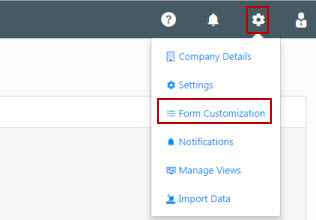
- The Form Customization screen will appear.

Module/Form - The Form options are Add Asset Quantity, Asset, Asset Type, Audit, Audit Reconcile, Audit Window, Calculate Depreciation, Check In, Check Out, Contract, Convert, Customer, Department, Dispose, Employee, Funding, Location, Main, Manufacturer, Mobile Add, Mobile Asset, Mobile Audit, Mobile Check In, Mobile Check Out, Mobile Convert, Mobile Details, Mobile Dispose, Mobile Funding Audit, Mobile Main Menu, Mobile Maintenance, Mobile Move, Mobile Receive, Mobile Work Order Asset, Mobile Work Order Task, Move, Purchase Order, Receive, Recover Asset, Roles, Shipping Provider, Site, Task, User, and Vendor.
Adding custom field - Form - Asset
- Select Asset in the Form field.
- Select Custom Field / General / Geo Location / Purchase Details in the Tab field.
- Select Custom Field / Asset Information / Geo Location / Purchase Details in the Section field.
Note: Adding custom fields on the geo location tab is not currently supported.
- Click on the New button.
- New Custom Field In screen will appear.
- Select Data Type. The options are Text, Numbers, Date/Time, Date, Pick List, and Extended Text.

- Text - is a standard text field into which you can type a value.
- Number - is a standard text field into which you can type a numerical value.
- Enter/Select the Decimal Places. This field will appear if the Data Type is set as Numbers.

- Date/Time - is a date/time field.
- Date - is a date field.
- Pick List - is a dropdown menu. You can add a list of values. The values can be easily searched using the search box provided at the top of the list.

- Click on the checkbox if you want to "Use first items as default value" in the pick list.
- Click on the checkbox if you want to "Accept values not in the list (indicates that users will be able to type in additional values that you did not include in your list)".
Example - Consider that you have added "one, two, three, four" as a pick list value. While entering the value in the custom field, if the user wants option "five". Then it can be easily added if this checkbox is selected.
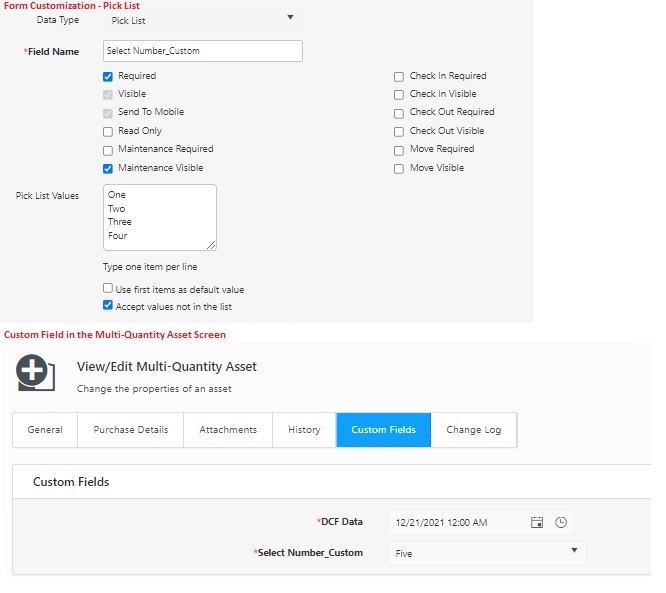
- Extended Text - Enter the Extended Text. It is used to extend the description for items by adding extra lines as extended text. Note: Extended Text Fields will not be visible on the list grids.
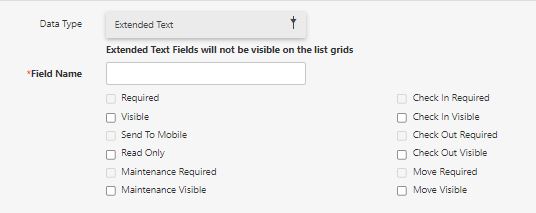
Customizing the fields
The newly created custom fields can be customized so that you can make them required, visible, and read-only. Additionally, it also includes maintenance and transactions related checkboxes that you can set as required or visible.
Note:
- The transactions - Check In Visible, Check In Required, Check Out Visible, Check Out Required, and Move Visible and Move Required are only available for Asset Form.
- The visible DCF fields for Check In/Check Out/Move transactions are applied ONLY for fixed assets.
- Check-In/Check-Out/Move - when any of these transactions are selected, the screen should not display DCF for Multi-Quantity assets (even when “all types”) are selected.

- Click on the checkbox (s) if the field is - Required, Visible, Send To Mobile, Maintenance Required, and Maintenance Visible.
- Required - Indicates that the custom field is mandatory. On selecting this option, the Visible and Read-Only checkbox will get automatically checked and become read-only.
- Visible - Indicates that the custom field is visible to all authorized users.
- Send to Mobile - Indicates that the custom field is sent to and visible on mobile devices.
- Read Only - Indicates that the custom field will be read-only. This checkbox will only appear for the Asset and Asset Type form.
- Maintenance Required - Indicates that the custom field is required and will appear on the maintenance screen. On selecting this option, the Maintenance Visible and Send to Mobile checkbox will get automatically checked and become read-only.
- Maintenance Visible - Indicates that the custom field is visible and will appear on the maintenance screen.
Note that the below checkboxes will appear only for Asset Form.
- Check In Required - Indicates that the custom field is required and will appear on the Check In screen. On selecting this option, the Check In Visible checkbox will get automatically checked and become read-only.
- Check In Visible - Indicates that the custom field is visible and will appear on the Check In screen.
- Check Out Required - Indicates that the custom field is required and will appear on the Check Out screen. On selecting this option, the Check Out Visible checkbox will get automatically checked and become read-only.
- Check Out Visible - Indicates that the custom field is visible and will appear on the Check Out screen.
- Move Required - Indicates that the custom field is required and will appear on the Move screen. On selecting this option, the Move Visible checkbox will get automatically checked and become read-only.
- Move Visible - Indicates that the custom field is visible and will appear on the Move screen.
- Place Field on
- All Asset Types - Select this radio button to have this Custom Field apply to all Asset Types.
- Selected Asset Types - Select this radio button to select one or more specific Asset Types from the list.
- Choose Asset Types - Click on the checkbox (s) to select the asset type where you want to place the New custom field. This field is applicable if you click on the Selected Asset Types in the Place Fields on.
- Click on the Save button.
Adding custom field - Module - Asset Type
- Select Asset Type in the Module field.
- Select Custom Field / General in the Tab field.
- Select Custom Field / Asset Type Information in the Section field.
- Click on the New button.
- A New Custom Field In screen will appear.
- Select Data Type. The options are Text, Numbers, Date/Time, Date, Pick List, and Extended Text.
- Enter the Field Name.
- Click on the checkbox (s) if the field is - Required, Visible, Send To Mobile.
- Enter/Select the Decimal Places. This field will appear if the Data Type is set as numbers.
- Enter the Pick List Values. This field will appear if the Data Type is set as Pick List.
- Click on the checkbox if you want to "Use first items (in the pick list) as default value".
- Click on the checkbox if you want to "Accept values not in the list (indicates that users will be able to type in additional values that you did not include in your list)"
- Extended Text - Enter the Extended Text. It is used to extend the description for items by adding extra lines as extended text.
- Click on the Save button. A message will appear indicating that the Custom field is successfully saved.
- The Custom Field will appear in the field list for the selected screen.

- The newly added custom field will appear in the designated Tab>Section
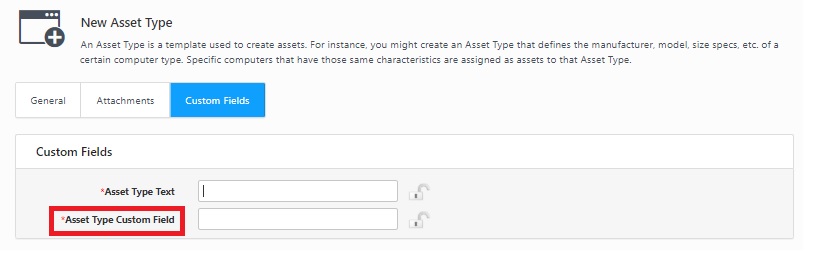
Updating the Custom Field
- Click on the Settings > Form Customization.
- The Form Customization screen will appear.
- Select the Form, Tab, and Section (if needed) to locate the field you want to modify. In the example below, we have selected the Asset screen > General tab.

- The custom fields with a checkbox will be listed on the screen.

- Click on the Field Name Link to update the custom field details.

- The View/Edit Custom Fields screen will appear.
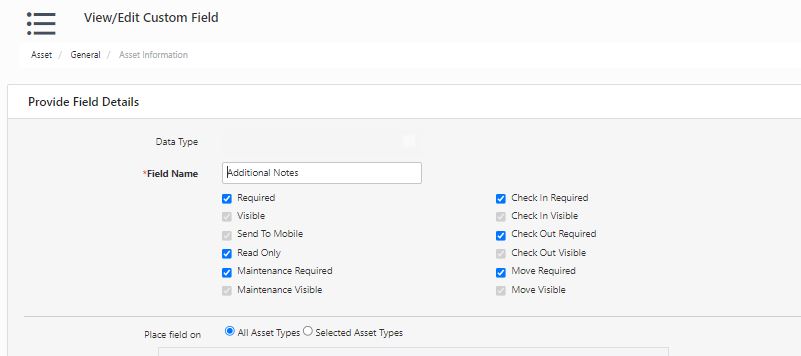
- Update the fields
- Update the Field Name.
- Update the Checkboxes.
- Click on the Save button.
- A message will appear indicating that the custom field is updated successfully.

Reset to Default
- In the Form Customization screen, select the Form, Tab, and Section.
- Select the In-built field that you want to Reset to Default.
- Click on the Field Name Link to update the custom field details.
- Click on the Reset to Default button and Save.
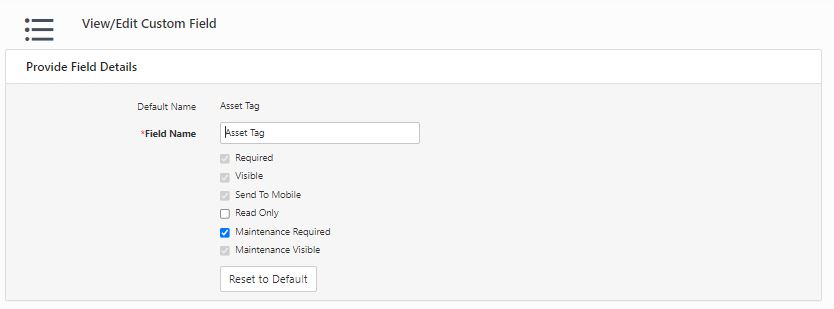
- The field name will return to the default value across all screens and reports.
Deleting a Custom Field
- In the Form Customization screen, select the Form, Tab, and Section.
- Search for the custom field that you want to delete.
- Select the custom field and click on the Delete button.
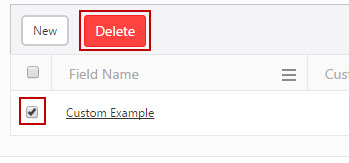
- A confirmation message will appear.
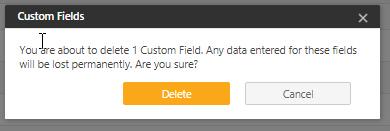
- Click on the Delete button again.


















